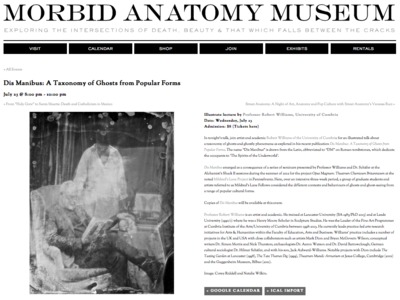Williams, Robert

![Williams_DisManibusA.png [thumbnail of Williams_DisManibusA.png]](https://insight.cumbria.ac.uk/4205/1.hassmallThumbnailVersion/Williams_DisManibusA.png)  Preview |
Image (PNG)
- Supplemental Material
Available under License CC BY-NC Download (451kB) | Preview |
Abstract
Illustrated public lecture by Professor Robert Williams, University of Cumbria. In tonight’s talk, join artist and academic Robert Williams of the University of Cumbria for an illustrated talk about a taxonomy of ghosts and ghostly phenomena as explored in his recent publication Dis Manibus: A Taxonomy of Ghosts from Popular Forms. The name “Dis Manibus” is drawn from the Latin, abbreviated to “DM” on Roman tombstones, which dedicate the occupants to ‘The Spirits of the Underworld’. Dis Manibus emerged as a consequence of a series of seminars presented by Professor Williams and Dr. Schäfer at the Alchemist’s Shack II sessions during the summer of 2012 for the project Opus Magnum: Theatrum Chemicum Britannicum at the noted Mildred’s Lane Project in Pennsylvania. Here, over an intensive three-week period, a group of graduate students and artists referred to as Mildred’s Lane Fellows considered the different contexts and behaviours of ghosts and ghost-seeing from a range of popular cultural forms. Copies of Dis Manibus will be available at this event. Professor Robert Williams is an artist and academic. He trained at Lancaster University (BA 1983/PhD 2013) and at Leeds University (1990/1) where he was a Henry Moore Scholar in Sculpture Studies. He was the Leader of the Fine Art Programmes at Cumbria Institute of the Arts/University of Cumbria between 1998-2013. He currently leads practice-led arts research initiatives for Arts & Humanities within the Faculty of Education, Arts and Business. Williams’ practice includes a number of projects in the UK and USA with close collaborators such as artists Mark Dion and Bryan McGovern Wilson; conceptual writers Dr. Simon Morris and Nick Thurston; archaeologists Dr. Aaron Watson and Dr. David Barrowclough; German cultural sociologist Dr. Hilmar Schäfer, and with his son, Jack Aylward-Williams. Notable projects with Dion include The Tasting Garden at Lancaster (1998), The Tate Thames Dig (1999), Theatrum Mundi: Armarium at Jesus College, Cambridge (2001) and the Guggenheim Museum, Bilbao (2011).
| Item Type: | Conference or Workshop Item (Lecture) |
|---|---|
| Departments: | Academic Departments > Institute of Arts (IOA) > Fine Arts |
| Depositing User: | Anna Lupton |
| Date Deposited: | 19 Nov 2018 15:39 |
| Last Modified: | 12 Jan 2024 13:00 |
| URI: | https://insight.cumbria.ac.uk/id/eprint/4205 |
Downloads
Downloads per month over past year
Downloads each year

 Share
Share Share
Share